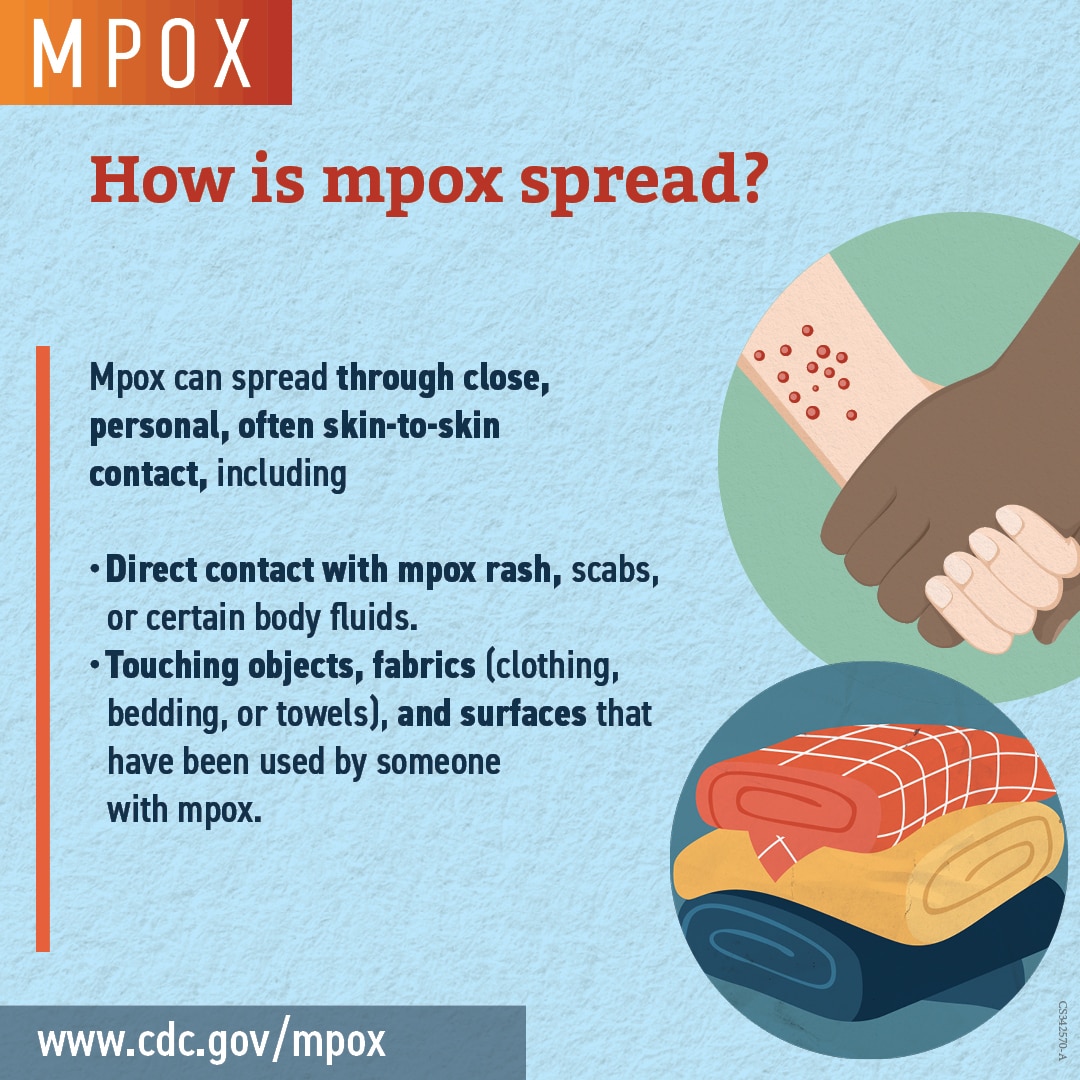At a glance
- Mpox spreads through close or intimate contact with a person with mpox, direct contact with an infected animal, or contact with contaminated objects.
- A person can spread mpox from the time symptoms start until the rash has fully healed.
- We are still learning about the different ways mpox can spread.

Types of mpox
There are two types of mpox: clade I and clade II.
Both clades can spread through direct contact with infected wild animals, through close contact (including intimate or sexual contact) with a person with mpox, and through contact with contaminated materials.
How it spreads
Close or intimate contact
Regardless of type, mpox can spread to anyone through close, personal contact, including:
- Direct skin-to-skin contact with mpox rash or scabs from a person with mpox
- Contact with saliva, upper respiratory secretions (snot, mucus), and bodily fluids or lesions around the anus, rectum, or vagina from a person with mpox
- Pregnant people with mpox can pass the virus to the fetus during pregnancy or to the newborn during and after birth.
Direct contact can happen during intimate contact, including:
- Oral, anal, or vaginal sex, or touching the genitals (penis, testicles, labia, and vagina) or anus
- Hugging, massage, and kissing
Touching objects
The virus that causes mpox can spread through contact with objects, fabrics, and surfaces that have not been disinfected after use by someone with mpox. This includes items like clothing, bedding, towels, dishes, utensils, fetish gear, or sex toys.
Infected animals
Mpox can spread from animals to people in a few ways:
- Through small wild animals in West and Central Africa, where mpox is endemic (found naturally).
- Direct close contact with an infected animal, fluids or waste, or getting bitten or scratched.
- During activities like hunting, trapping, or processing infected wild animals in areas where mpox is endemic.
People are less likely to get mpox from a pet, but it's possible. Close contact with a pet that is infected, including petting, cuddling, hugging, kissing, licking, and sharing sleeping spaces or food, can spread mpox to a person.
To reduce the risk of spreading mpox between animals and people:
- Avoid close contact with an animal that might have mpox.
- Those who have mpox should avoid contact with animals, including pets, to prevent spreading the virus to them.
How mpox does not spread
Through the air
The virus that causes mpox is known to spread through close, interpersonal contact, including direct touching (including sex), or sharing items like towels, beds, etc. The disease is not known to spread in settings where only respiratory spread is possible – for example, across rooms, in markets or classrooms, etc. Some studies suggest that the virus can be found in respiratory droplets, and spread has been shown to sometimes occur between animals in a lab housed separately but very close to each other, for long periods of time. However, information from real-life outbreaks suggests the likelihood of human-to-human respiratory transmission of the virus that causes mpox appears to be low. Currently, CDC recommends that persons with mpox should wear a mask when around others, such as when they are receiving care. CDC also recommends that persons taking care of someone with mpox (care givers, healthcare workers, etc.) use appropriate personal protective equipment.
Hot tubs or pools
No studies have found a clear link between mpox and water in pools, hot tubs, or splash pads. The mpox virus is killed in water at the chlorine levels recommended for disinfection in recreational water venues by CDC and required by U.S. jurisdictions.
When the disease can be spread
A person can spread mpox:
- From the time symptoms start until the rash has fully healed and a fresh layer of skin has formed.
- Sometimes, from 1 to 4 days before they have symptoms.
Currently, no evidence suggests that people who never have symptoms can spread the virus to someone else. CDC is monitoring the latest information about how mpox spreads.
